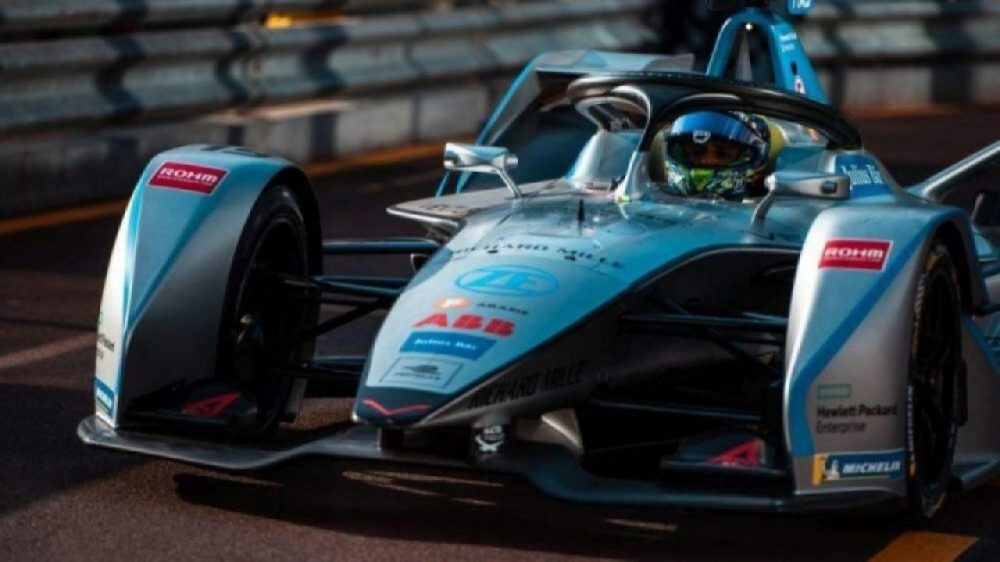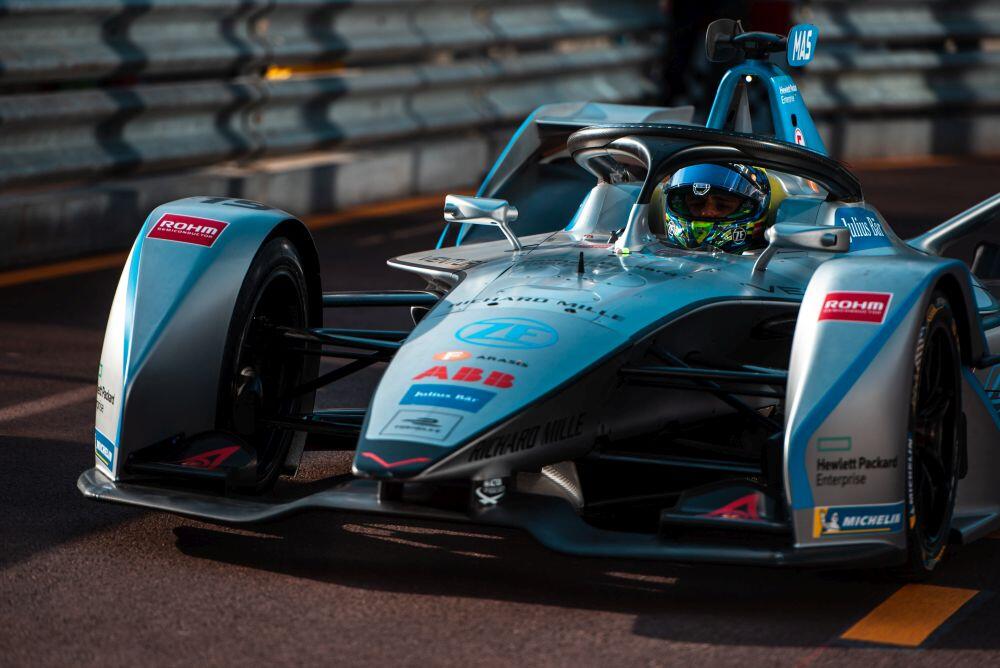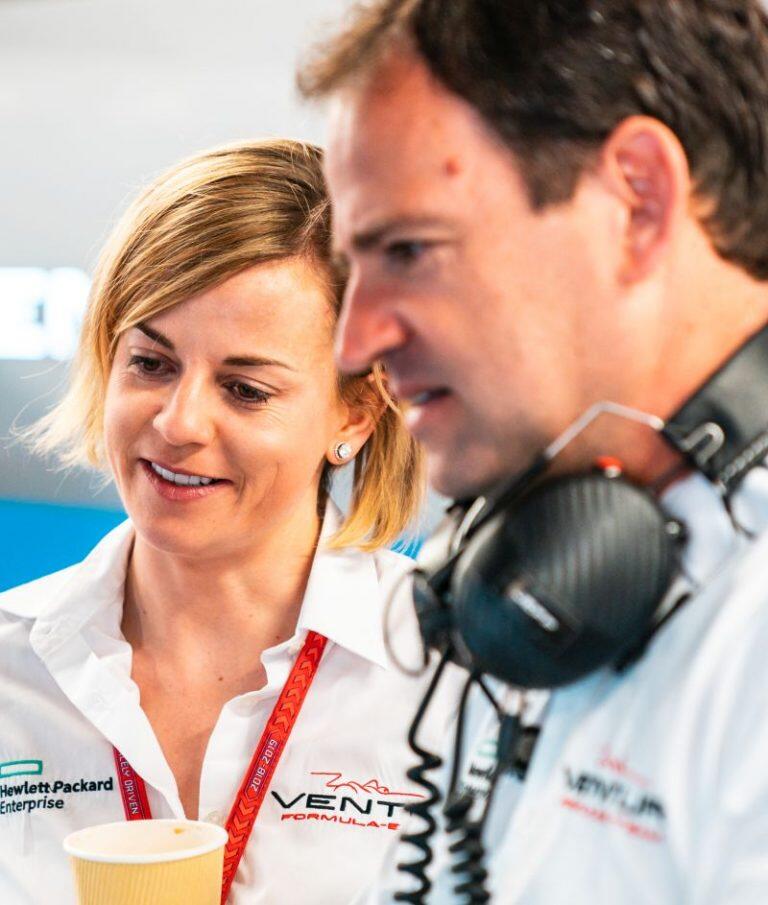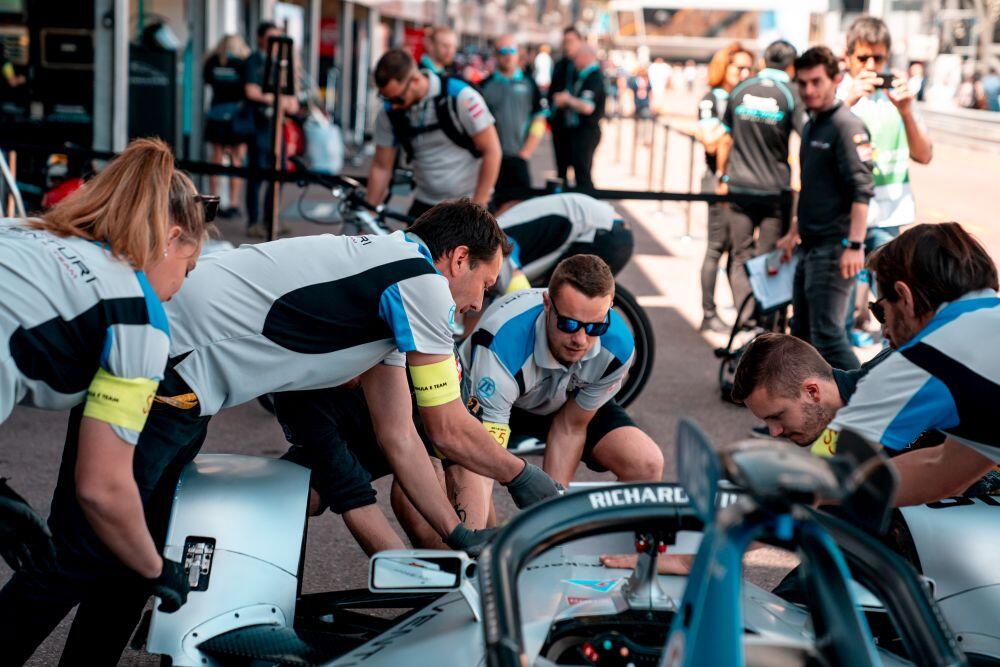Next Gen Race Car Pushes Formula E
Article By : Sally Ward-Foxton

EE Times visited the Venturi garage, where the home team was preparing its vehicle for their next race.
Against the backdrop of one of the most famous venues in motorsport, the notorious Monte Carlo street circuit, the Formula E electric vehicle championship last month showed off just how far the teams, drivers, and technology have come since the series started in 2014. It is essentially a technology competition, showcasing the cutting edge of electric vehicle powertrain technology that will eventually end up in all electric cars.
EE Times Europe visited the Venturi garage, where the home team was preparing its vehicle for the race. A different team had won each of the preceding eight races of the season, and with less than a second separating all the teams in qualifying, anything was possible. It was, and still is, an extremely exciting time for the championship.
SECOND-GENERATION CAR
While about 80% of each car is standardized, with teams working primarily on powertrain innovations, the car has been totally redesigned for this season. The second-generation (Gen2) car includes new features such as an LED strip along the titanium head protection Halo, which glows in different colors depending on the racing mode the driver selects, so that fans can easily follow drivers’ strategies.
“I was impressed with how quick the Gen2 car is — it’s at least five or six seconds faster between Gen1 and Gen2,” said Simona De Silvestro, test driver for Venturi. “It’s much nicer to drive as well; it feels more like a proper race car.”

The Gen2 design has overhauled practically every part of the vehicle. The body has been redesigned to allow drivers to maintain grip when closely following another car, with a huge underfloor diffuser added to increase downforce. This means that the rear wing can be smaller. The front wheels have also been partially enclosed to help reduce turbulence for cars behind.
Another big change this year is the battery. Its capacity has almost doubled, from 28 kW to 54 kW, and it can be fully charged in 60 minutes. The extended capacity means that the entire race can be completed without charging cars as in previous seasons (unlike Formula 1, each race is 45 minutes, plus one lap, to add an element of battery life to the competition). The maximum power output of the Gen2 car is 200 kW during normal operation and up to 250 kW during boost mode. Potential top speeds are now in the region of 280 km/h (174 mph), with cars achieving 0–100 km/h in about three seconds.
DRIVING THE CAR
Driving the all-electric vehicle demands different skills than traditional racing. Drivers spend many hours in simulators, not only to practice on the different tracks but to learn the best way to manage the available electric power and systems, such as the regenerative brakes.
“Formula E is really tricky because as a racing driver, you usually just go full tilt for the whole race, perhaps with a bit of tire management, but in Formula E, you have to manage the energy,” De Silvestro said. “You might feel like you can pass someone, but it might use too much energy, so you have to think a lot about the race and the strategy. Maybe you have to be a bit patient because you have to keep enough energy to manage until the end of the race — as a driver, that can be quite demanding!”
Drivers also need to learn about the technology, she said. “As a driver, the big thing you focus on is the feel of the car — the efficiency is more in the team’s hands. But for sure, I think you need to understand how it works, because the energy management is a big part of Formula E … with [things like] the battery temperature and how it can affect that in the race, the more you know about it, the better it helps.”
POWERTRAIN INNOVATION
With much of the car standardized among the teams, the powertrain is where much of the innovation happens. Even minute improvements in component efficiency in the inverter, the motor, or the transmission can help to make the car more powerful.
“It’s a continuous work in progress,” said Venturi team manager Delphine Biscaye. “We work on the motor, the battery [system], and the inverter; ROHM works on the IGBTs; and developments made in all those components make [the powertrain] more efficient. We work continuously to make more efficient, more powerful components in the same size and weight, so it fits in the car … Our powertrain is [a collaboration with] ZF and ROHM. We make progress every race, and we are really close to the companies we work with, but it’s an ongoing process from one season to the next.”
In practice, finessing the performance between races comes down to software. Once the hardware design is fixed, teams are allowed to make changes only to improve reliability or safety, so performance improvements on the hardware side are quite limited.
“The big race in Formula E is the software race,” said Venturi team principal Susie Wolff. “Software is a much bigger performance factor than the hardware. That’s why, as the season progresses, you’ll see the teams are able to react quickly on the software side. We certainly had a difficult start to the season but were able to claw back [some performance] on the software side.”
One of the main issues this season has been the brake-by-wire (BBW) system in the Gen2 car, said Wolff. Formula E brakes are a combination of hydraulic brakes and a regenerative braking system (regen). Regen acts as torque on the wheels, but the amount is variable because it depends on the status of the battery (when it’s close to empty, the power coming from regen needs to be reduced, too), as well as the battery temperature and other factors.
With the Gen1 car, the regen system worked in discrete levels, and drivers had to be trained to handle the transition between them. In previous seasons, drivers frequently lost control of their cars because the battery’s state of charge and the drop-off in regen unbalanced the car. With BBW, software handles the driver’s request for brake torque, splitting it between the regen system and the hydraulic brakes automatically. The aim is to provide a more balanced and consistent braking effect for the driver.
“It’s very complex to get [brake by wire] working consistently and get the driver having the same brake pressure every time when they come into the corner,” said Wolff. “But we have some great technicians on the software side. Through programming and through lots of work in the simulator, we were able to very quickly improve on that side, and that’s where we gained the most performance [this season].”
TEAM DIVERSITY
Venturi is a relatively diverse team in the world of motorsport, which is notoriously male-centric. Seven of the 30 people on the team are women, working at all levels from management to mechanic. Has this been a deliberate choice or something that happened naturally?

“The big race in Formula E is the software race … software is a much bigger performance factor than the hardware.” — Susie Wolff, Venturi team principal
“[It happened] naturally — [we chose] the best people for the job!” said Biscaye. “We just look at the competencies of the person and see if they fit well … if their attitude and character are what you expect for your team, then we don’t care if they are a man or a woman.”
Biscaye started as a mechanical engineer with the Williams team in Formula 1, working on the kinetic-energy recovery system (she jokes that, in a way, she’s always been in electric vehicles). At Venturi, she started in mechanical design, then moved to project management with the Antarctica project and the company’s land speed world record vehicle. With her background in Formula 1, she was a natural fit when Venturi moved into Formula E.
De Silvestro and Wolff, meanwhile, have had long careers as drivers. Both started racing when they were small children. All members of Team Venturi are passionate about encouraging girls and women to pursue careers in motorsport and motorsport tech.
“You need to start early — you need to explain it to little girls!” said Biscaye. “You need to have more girls interested in technology and motorsport, to go that way at the first step, so that you can eventually hire them … when you make the choice when you’re 16, you don’t know what an engineer does, so that’s something people should focus on explaining — these careers exist, and this is what you can do.”
“The first point is to lead by example,” said Wolff. “We have a lot of women on the team, and they are not on the team because they are women! In the end, I’m responsible for the performance of the team. It’s on my shoulders if the team functions, [so] we have the best people in every area, and it just so happens that [a large proportion] of Venturi are women. I am a great believer in creating opportunity — if we want the sport to become more diverse, we have to make sure we follow up and give opportunities where it’s possible.”
Wolff’s initiative, Dare to be Different, aims to inspire the next generation of women in motorsport. The program showcases female talent in motorsport and related industries, counting many female broadcasters, drivers, engineers, and scientists as ambassadors. The initiative also organizes events and race days for school-aged girls.
“We want to inspire the next generation, and that’s not just on the racing track; it’s about opening up the whole sport,” said Wolff. “Here, at the E-Prix in Monaco, there are 20 drivers on the track, but there are about 2,000 people responsible for the running of the event — from the teams to the organizers — and we need to make sure every area of the sport becomes more diverse.”
THIS SEASON
Since taking the helm at Venturi at the beginning of this season, Wolff’s aim is for the team to take a step forward. Formula E is a very competitive environment, and with the level rising every season and the big manufacturers now in the running, the pressure is on.

“We were lacking consistency and good results last season, and we’re actually ahead of schedule; we’ve won a race already this season,” she said. “My end goal is [for Venturi] to be consistent frontrunners. We want to be consistently heading the podium in Formula E, and we’re on the way to achieving that … it’s about making sure that not only can we achieve the top result, but we’re consistently fighting at the front.”
Wolff got her wish in Monte Carlo: Venturi driver Felipe Massa, after starting in fourth place, was able to take advantage of a mistake from Pascal Wehrlein after nine minutes and successfully held him off for the rest of the race to finish third.